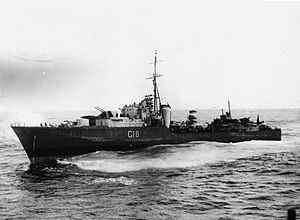HMS Zulu (F18)
 Zulu
| |
| History | |
|---|---|
| Name | Zulu |
| Namesake | Zulu people |
| Ordered | 10 March 1936 |
| Builder | Alexander Stephen and Sons, Linthouse |
| Cost | £351,135 |
| Laid down | 27 August 1936 |
| Launched | 23 September 1937 |
| Completed | 6 September 1938 |
| Identification | Pennant numbers: L18, later F18 |
| Fate | Sunk by aircraft, 14 September 1942 |
| Badge | On a Field Barry, wavy of six white and blue; in front of two Zulu spears in saltire surmounted a Zulu shield all proper |
| General characteristics (as built) | |
| Class and type | Tribal-class destroyer |
| Displacement |
|
| Length | 377 ft (114.9 m) (o/a) |
| Beam | 36 ft 6 in (11.13 m) |
| Draught | 11 ft 3 in (3.43 m) |
| Installed power |
|
| Propulsion | 2 × shafts; 2 × geared steam turbines |
| Speed | 36 knots (67 km/h; 41 mph) |
| Range | 5,700 nmi (10,600 km; 6,600 mi) at 15 knots (28 km/h; 17 mph) |
| Complement | 190 |
| Sensors and processing systems | ASDIC |
| Armament |
|
HMS Zulu was a
Zulu was sunk by German or Italian aircraft on 14 September 1942, off Tobruk.
Description
The Tribals were intended to counter the large destroyers being built by other nations and to improve the firepower of the existing destroyer
The primary armament of the Tribal-class was eight
The ships were fitted with an above-water quadruple mount for
Wartime modifications
Heavy losses to German air attack during the
Construction and career
Authorized as one of seven Tribal-class destroyers under the 1935 Naval Estimates,
During 1940 she developed engine trouble and was
In April 1941 she was assigned to provide Atlantic convoy defence as part of the RN's 4th Destroyer flotilla. On 22nd May 1941 she joined military convoy WS8B as local escort during its passage in the western Approaches together with HMS Cairo, and the destroyers HMS Cossack, Bridge, Maori, Ottawa (RCN), ORP Piorun (Polish), Sikh & Restigouche (RCN). On the 26th May she was detached from the escort to relieve the destroyer escorts of HMS King George V during her search for German Battleship Bismarck. on the 27th she carried out torpedo attacks on Bismarck with destroyers of RN's 4th destroyer Flotilla.
On the 14 September Zulu, Sikh and the
The type II Hunt-class destroyer, HMS Croome came alongside to take off the surviving personnel, save for a towing party and Zulu was taken under tow by HMS Hursley. By 19:00 hours and a hundred miles from Alexandria, it was clear she was sinking and the towing party was recovered after a strafing pass by an enemy aircraft. Soon after, Zulu rolled to starboard and sank in position 32°00′N 28°56′E / 32.000°N 28.933°E. Across both attacks, twelve men were killed, twenty-seven were missing and one was wounded.[21]
Notes
- ^ Rohwer 2005, p. 196.
- ^ de Zeng, Stankey & Creek 2009, p. 109.
- ^ Weal 1998, p. 65.
- ^ a b Smith 2008, pp. 188–189.
- ^ Lenton, p. 164
- ^ English, p. 14
- ^ a b Lenton, p. 165
- ^ a b English, p. 12
- ^ March, p. 322
- ^ a b Whitley, p. 99
- ^ Hodges, pp. 13–25
- ^ Friedman, p. 32
- ^ Hodges, pp. 30–31, 40
- ^ English, p. 15
- ^ Friedman, p. 34; Hodges, pp. 41–42
- ^ Whitley, p. 116
- ^ Brice, p. 11
- ^ Colledge & Warlow, p. 396
- ^ English, pp. 13, 16
- ^ HMS Coventry (D 43) at Uboat.net
- ^ HMS Zulu (F18) at Uboat.net
References
- Brice, Martin H. (1971). The Tribals. London: Ian Allan. ISBN 0-7110-0245-2.
- English, John (2001). Afridi to Nizam: British Fleet Destroyers 1937–43. Gravesend, Kent: World Ship Society. ISBN 0-905617-64-9.
- de Zeng, H.L.; Stankey, D.G.; Creek, E.J. (2009). Dive-Bomber and Ground-Attack Units of the Luftwaffe, 1933–1945: A Reference Source, Vol. 1. Ian Allan Publishing. ISBN 978-1-9065-3708-1.
- ISBN 1-86176-137-6.
- Haarr, Geirr H. (2010). The Battle for Norway: April–June 1940. Annapolis, Maryland: Naval Institute Press. ISBN 978-1-59114-051-1.
- Haarr, Geirr H. (2009). The German Invasion of Norway, April 1940. Annapolis, Maryland: Naval Institute Press. ISBN 978-1-59114-310-9.
- Hodges, Peter (1971). Tribal Class Destroyers. London: Almark. ISBN 0-85524-047-4.
- ISBN 1-55750-048-7.
- ISBN 1-59114-119-2.
- Smith, Peter C. (2008) [1987]. Massacre at Tobruk: the British assault on Rommel, 1942: the Story of Operation Agreement. Stackpole Books. ISBN 978-0-8117-3474-5.
- ISBN 0-87021-326-1.
- Weal, John (1998). Junkers Ju 87 Stukageschwader of North Africa and the Mediterranean. Oxford, UK: ISBN 978-1-85532-722-1.
External links
- Uboat.net
- HMS Cavalier.org
- HMS Zulu (F18) at Wrecksite.eu
- www.Unit histories.com Archived 8 April 2018 at the Wayback Machine White, Richard Taylor
